|
In the Mexican equivalent of the Old West, six patients escape from the San Lazaro leper hospital. The institute's head medico, Dr. Ramos (Carlos Agostí), belts over to the nearby town of Santa Fe to warn Sheriff Dario (Armando Silvestre) of the potential danger these escapees represent. At the same time he suggests that they should treat these men with compassion, and capture them as soon as possible to stop them being killed by the frightened locals. Seconds later, the lepers in question break into a couple of local homes in search of food and new clothing, scaring the bejesus out of their occupants, who respond by running away in terror.
With the rabble being roused by cocky troublemaker Camerino (Julio Aldama), Sheriff Dario does his best to calm the panicking townspeople, while Dr. Ramos outlines to them the sometimes over-exaggerated risks of leprosy. Physical contact or an exchange of bodily fluids is required to spread the disease, he tells them, which sounds about right. He also claims, however, that you can also catch it from anything a leper has touched, and as a result the houses that the lepers entered the previous evening must be burned down, just to be safe. Yeah, not sure about that one, doc. That said, it's worth remembering that a lot more is known about leprosy now – or to give it its proper name, Hansen's disease – and its communicability and treatment than was way back in 1970 when this film was made, and a hell of a lot more than in the period in which this story is set. The fearful reaction of the citizens of Santa Fe is, in all likelihood, a reasonably accurate reflection of attitudes of the day. And when it comes to the initial suggestion of lepers as dangerous and deformed monsters to be screamed at and rapidly run away from, the film has a few pleasant surprises up its sleeve.

Dario organises a posse of men to search for the missing lepers, but they have no luck. The fear in the community continues to grow, and when a masked intruder breaks into the house in which the Sheriff's girlfriend Carmen (Mary Montiel) lives and shoots her father in the back, the lepers are immediately blamed for his murder. It's soon revealed to us that the intruder was a member of a criminal gang run by Camerino, who has a plan to make them all rich by striking a deal with the lepers. Having somehow learned that they are hiding in a nearby cave, he offers to bring them food and wine and split the profits of anything they steal in exchange for being able to hide their spoils in their cave hideout. He also requests that two of them accompany his gang on their raids in order to scare the crap out of everyone present and prompt them to leave without a fuss. In its dastardly way, it's actually rather clever.
So what about that title, Santo vs. the Riders Of Terror (Santo contra los jinetes del terror)? If you come to this film previously unaware of the name El Santo (whose real name was Rodolfo Guzmán Huerta), it'll doubtless have you scratching your head. If you've already got a few Santo films under your belt – and Indicator's earlier two-film Blu-ray box set Enter Santo: The First Adventures of the Silver-Masked Man is a great place to start* – then you'll by this point be wondering how our favourite lucha libre hero can possibly be shoehorned into this particular story.
Before I go on, if you are new to El Santo, it's worth knowing up front that he was a hugely popular wrestling star and cultural icon in his native Mexico. His trademark was a silver cloth mask that covered his entire head, with distinctively shaped holes for his eyes nose and mouth, a costume accessory popular with luchador enmascarado (literally 'masked wrestlers'). Having risen to widespread fame in the ring and as a popular comic book character, he went on to appear in over 50 films, usually as a respected crime-fighting hero, and almost always as himself wearing his distinctive mask. Come to any of these films with no foreknowledge and you may find the sight of a bare-chested wrestler in a cape and silver mask assisting the authorities or fighting supernatural creatures a little absurd. But what if he was dressed in a costume inspired by a bat, making him a bat man, if you will? We don't laugh at that now because the figure of Batman has become so ingrained into western culture. Well, for a good many years it was exactly the same story with El Santo, and if your memory stretches back to the Adam West Batman TV series, the parallels between those two characters go further than just their capes, their feature-disguising masks, and their respective fights against criminality and evil.
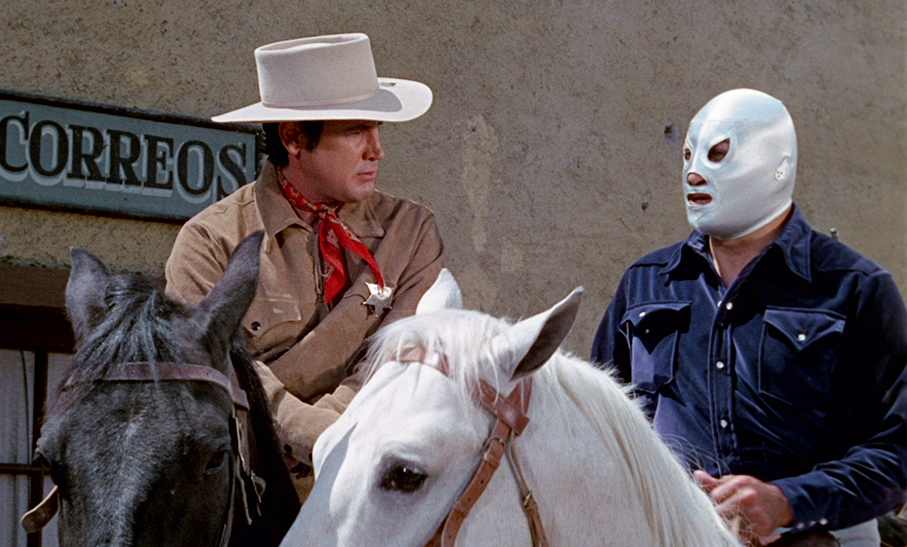
So how does El Santo fit into this essentially western tale? We're over 20 minutes into the story before this is revealed, when a travelling sideshow barker in a neighbouring town challenges onlookers to beat his wrestler, El Toro. The entry fee is just 100 pesos, but if you beat El Toro you could pocket the princely sum of 10,000 pesos. Of course, El Toro is way tougher than all of the hapless challengers expect, knocking each of them down and seemingly able to take even the hardest blow without even flinching. It's all above board, so why would Santo want to take him on? Well just think what that 10,000 pesos could do for the orphans he tells the three nuns who excitedly egg him on. What may surprise newcomers is that Santo is not a punch-your-lights-out fighter in the Jack Reacher mode, and gets knocked down repeatedly by El Toro, only coming out on top after a prolonged battle that he intermittently shows signs of losing. A short while later he's by Dario's side and helping him to track down the lepers and prove that they were not the ones committing the recent crimes for which they have been wrongly blamed.
Santo vs. the Riders Of Terror was directed by Mexican B-movie legend René Cardona, who by this point already had four Santo films under his belt and a string of non-Santo lucha libre films**. He handles this one with pacy gusto, keeping the story moving at a nippy speed that pauses only to watch Santo get into extended fights with foes who are sometimes close to his wrestling or punching equal. Another link to the aforementioned Batman TV series comes in the scene transitions, which here consist of psychedelically coloured whip-pans accompanied by a rising or falling strum on the strings of a harp. If you find this irritating, get used to it fast, because Cardona uses it a lot. A solid cast really helps. Carlos Agostí is sincere as Dr. Ramos, and even gets to outline the specifics of the two main types of leprosy to the interested Santo, who recognises the significance of his words but chooses to act on his conclusion instead of explaining it in expositional terms. As the film's romantic lead, Armando Silvestre makes for an upstanding if unexciting Dario, while Julio Aldama's performance as the morally bankrupt Camerino could have landed him regular work playing bad guys in Hollywood westerns a couple of decades earlier. As for Santo, well, he's Santo, only as expressive as his mask and his lack of a formal acting background will allow, but somehow always likeable and easy to root for.
What impresses most is that after the initial panic at the news that the lepers are on the loose and the almost horror movie presentation of them as disfigured monsters, the film then sides with the afflicted escapees, sympathising with their plight and encouraging us to do likewise (I did from the start, but that's me). There's a touching moment when Camerino asks the lepers' leader José (Gregorio Casal) why they escaped in the first place, and he replies in all sincerity that they just wanted to die in the open air, as being locked up in San Lazaro was like being buried alive. It's also José who is the first to have misgivings about the plan that he has agreed to assist, evident from his telling post-raid expression rather than anything he specifically says. Sympathy for him is later cranked up several notches when he takes a temporary leave from the gang to pay a visit to his former fiancée Lupe (Ivonne Govea). Even eight years on from when they last saw each other, and despite discovering that her boyfriend has contracted leprosy, Lupe still expresses her love for José and her hope that there will one day be a way for them to be together again.
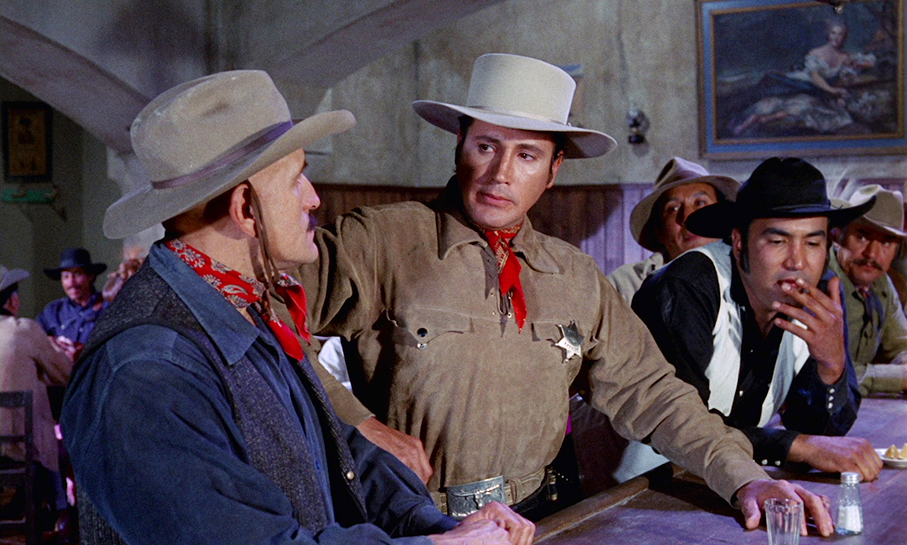
On paper, this collision of western, horror and lucha libre just shouldn't work, but I really enjoyed Santo vs. the Riders of Terror, even though when I first read that title I assumed that silver-masked hero was going to be pitted against an evil motorcycle gang instead. That's still a film I'd rather like to see. The western elements are faithful to the genre's codes and conventions, including some day-for-night photography by the insanely prolific Raúl Martínez Solares and a score by Gustavo C. Carrión that I have little doubt was heavily influenced by Hollywood westerns of years past. That Santo seems to win fights by gradually wearing down his opponent does occasionally slow the pace and had me intermittently aching to see him deliver the sort of killer blow that would justify his fearsome reputation. Not that this matters to the excited trio of nuns who forget their peaceful calling to cheer him on during his battle with El Toro ("Cut his ears and tail off!"), or to the torch-bearing mob of townspeople who march to the leper hospital with the intention of burning it down, a destructive move that El Santo is able to halt with just a few reassuring words. What a guy.
As well being released under the original title Santo vs. the Riders of Terror, the film also existed in a longer softcore export version under the frankly leery title, Lepers and Sex (Los leprosos y el sexo). Both cuts have been included on this disc, and while essentially the same film, three softcore sex scenes have been added for the export version. One of them has not aged well at all.
The first of these occurs near the start when the lepers enter the first house in search of supplies. In the original cut, a young man and woman are seen lying in bed, each dressed in a robust set of nightclothes (you could wear the woman's nightdress to a dance, no problem), and the woman wakes and screams at the sight of the lepers standing in the bedroom doorway. This wakes her partner and the two scrabble out of bed as the lepers ominously walk towards the camera like the title characters in John Gilling's Plague of the Zombies (1962). In the alternative cut, the couple get naked and have unconvincingly 'performed' cowgirl sex until the woman spots a leper staring at them through a window from outside (this is a new shot), then it's back to the lepers at the door and the couple making a hasty exit, this time in the buff.
The second additional scene takes place when the outlaws raid a saloon and the customers are persuaded to run for their lives by the appearance of two of the lepers. One woman mysteriously fails to move, and instead just sits at a table screaming wildly. In the original cut, the masked Camerino silences her by knocking her out cold with his gun. In Lepers and Sex, he instead picks her up and carries her into a nearby barn, tears her clothes off and rapes her. Depressingly, that's not the worst of it. Not only does the woman offer little resistance, but once the rape begins she starts to visibly enjoy the experience, responding to Camerino's actions like she would to those of a treasured lover. Compounding the problem is music that switches from crash-bang horror to sex scene saxophone and Hammond organ warbles that encourage the audience to see this as a major turn-on. Sorry mate, no bloody sale.
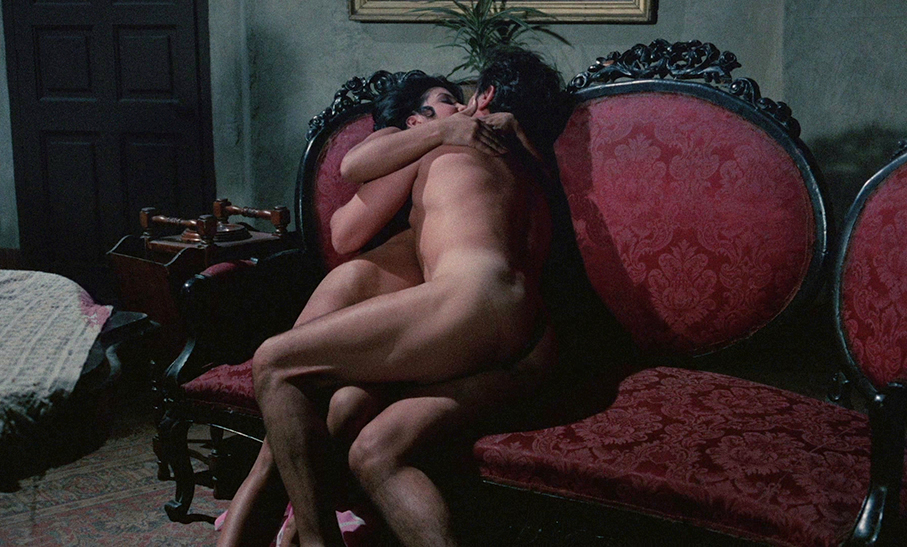
I was genuinely surprised when the third added sequence does not take place during the flashback in which José and Lupe recall happier times, but immediately afterwards when Dario returns home to Carmen and the two strip off and starts canoodling in the nude to some cheesy 'let's get sexy' music. In common with its predecessors, this feels like what it is, an artificial pause in the otherwise concise storytelling for a bit of would-be erotic distraction. This new material does cement the film's exploitation credentials, but for my money the narrative flows more fluidly without it.
Both Santo vs. the Riders of Terror and Lepers and Sex were restored in 4K by Permanencia Voluntaria and Cinema Preservation Alliance from a combination of original camera negatives and master positive elements, then transferred in 1080p for this Blu-ray by Powerhouse Films in their original aspect ratio of 1.66:1. The results are rather lovely, with sharp and clearly defined detail and a well-balanced contrast range with solid black levels and decent shadow detail. Colour is attractively handled, and while there is a slightly earthy hue to some exteriors and a blueish tinge to some other scenes, elsewhere it looks fine and prime colours are vibrant without over-saturation. The only real sign of wear that I spotted occurs during a wide shot just after Santo has entered the ring against El Toro, and the colour balance flickers briefly between warm and cool, but this doesn't last long. A couple of shots in the saloon raid are also a tad less crisp and have more visible film grain, doubtless a reflection of the dual sources used for the restoration.
The Linear PCM 1.0 mono track was remastered from the film's original optical soundtrack, and while the tonal range is a little narrow, with no real bass and some slight hissing on the letter S, the dialogue, music and effects are otherwise clear. I didn't notice any background fluff or other damage.
Optional English subtitles are activated automatically when you play either version of the film, but can be switched off on the fly or via the main menu if you prefer.
Audio Commentary with David Wilt on Lepers and Sex
Rather than analysing the story and themes or deconstructing individual scenes, film historian and Mexican cinema specialist David Wilt elects to focus primarily on the performers, with career details provided on almost every actor who has a speaking role. He also looks at the career of director René Cardona, points out where actors have been obviously doubled, and reflects on the problematic nature of that rape scene. He also reveals that those colourful swish-pan transitions were far from unique to this film at this point in Mexican film history.
Armando Silvestre: The New Sheriff in Town (12:14)
Actor Armando Silvestre, who plays Sheriff Dario in Santo vs. the Riders of Terror, looks back at his early career and meeting and working with members of the Calderón family of film producers, whose catalogue includes several Santo films, this one included. He also confirms that Santo was a humble man who only ever removed his mask in his dressing room, and would even leave it covering half of his face when eating in the studio restaurant.
The Killer Film: Western a la Mexicana (11:42)
Decked out in a black and red wrestling mask adorned with a silver unspooling film motif, lucha libre specialist and filmmaker known as the Killer Film looks at the production of Santo vs. the Riders of Terror, which apparently was the first of his own films that Santo invested money into. He also talks about Santo and Dracula's Treasure (Santo en El tesoro de Drácula, 1969), another collaboration between producer Guillermo Calderón and director René Cardona that had an adult recut, this time as The Vampire and Sex (El vampiro y el sexo). I see a pattern emerging here. This version that was considered lost until early in the twenty-first century, when it was rescued and restored by Viviana García Besné. This must have come as a blow to lead actor Aldo Monti, who for years had been denying its existence.
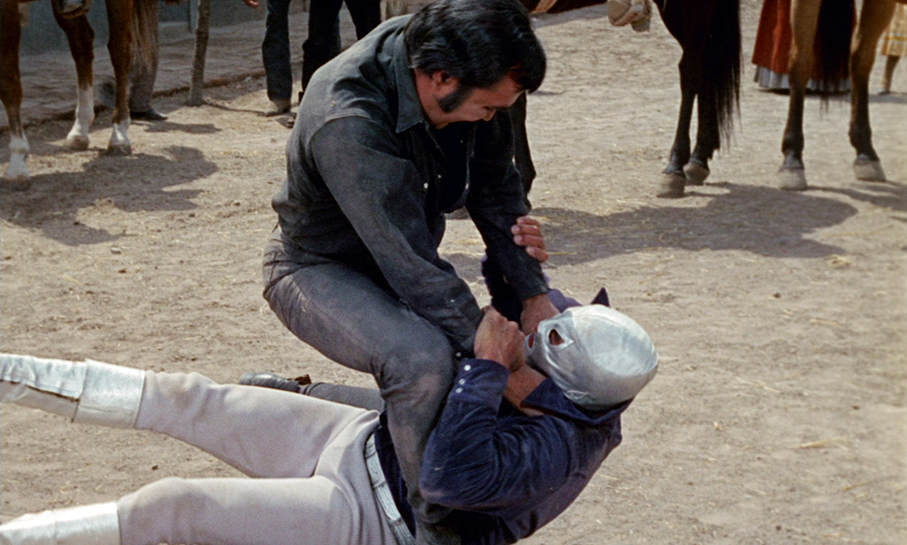
Armando Hernandez: Cardona Bonanza (8:13)
Writer, programmer and creator of the Trash-Mex website, Amando Hernandez, takes us on a concise trip through the film careers of René Cardona, his son René Cardona Jnr., and his grandson René Cardona III, who also worked under the name Al Coster.
Alternative French Titles (1:43)
As the title of this special feature says, the opening titles for the French export version. Not much more I can say about that.
Original Theatrical Trailer (4:03)
A bright, 4:3-framed Mexican trailer with sideshow barker narration and a contradictory attitude to the in-film lepers, as we're asked to show compassion for "these poor, sick men" after being assured that the sight of them will make you "scream in horror." Intriguingly, this prompts our narrator to question whether God really did make man in his own image after all. Answers on a Catholic postcard, please.
Image Gallery
55 screens of promotional stills, monochrome and colour lobby cards, comic book covers, magazine ads, press book pages and posters.
Booklet
Following the credits for both Santo vs. the Riders of Terror and Lepers and Sex (the only real difference here is the running time), this beefy, 78-page booklet kicks off with an essay on the film by Colin Gunckel, associate professor of film, television, and media, American culture and Latina/o studies at the University of Michigan, and the author of Mexico on Main Street: Transnational Film Culture in Los Angeles Before World War II. That won't be the last lengthy book title referenced here. I like that Gunckel begins by describing the film as one that defies explanation, only to then proceed to answer some of the questions raised by this comment. It's a knowledgeable and hugely informative piece that examines the film in the context of the lucha libre genre, the career of producer Guillermo Calderón, and his production company, Cinematográfica Calderón.
After this there are extracts from Doyle Greene's book titled (deep breath) Mexploitation Cinema: A Critical History of Mexican Vampire, Wrestler, Ape Man and Similar Films, 1957-1977, that discuss Santo's position as an icon of Mexican culture and the semiotics of lucha libre. The text that follows is a lot more accessible and educational than that borrowed overview probably makes it sound. Once again, I learned a lot here.
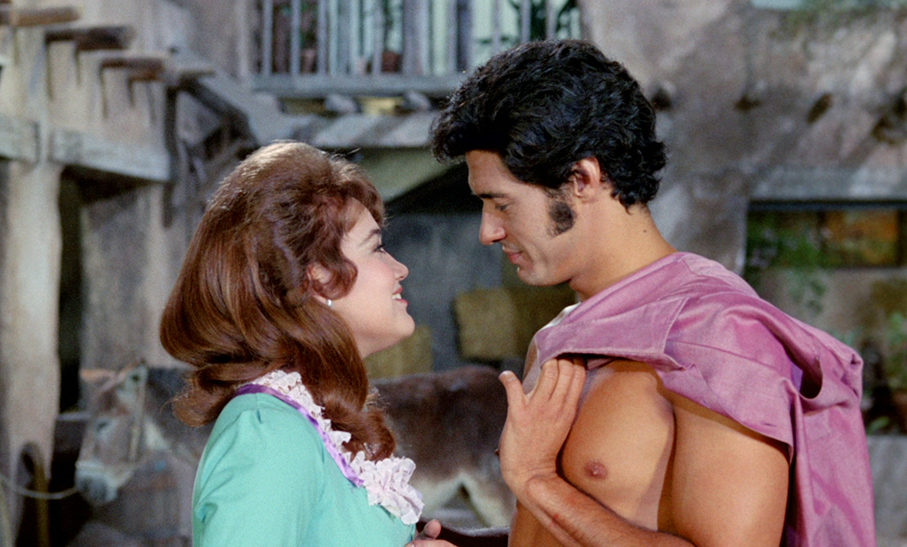
Next is a short 1968 magazine piece on a personal appearance made by Santo in the Columbian capital of Bogotá after the filming of Santo frente a la Muerte (Santo Faces Death, 1969), which includes an interview with Santo in which he explains why he always wears a mask in public.
The next piece, by scholars Olivia Cosentino and Brian Price, is taken from the introduction to their edited volume, The Lost Cinema of Mexico: From Lucha Libre to Cine Familiar and other Churros. Here, the authors – and I'm lifting this straight from the booklet's introduction to this piece because I can't come up with a better worded alternative – "contrast the attitude of the Cineteca Nacional de México towards popular genre films (such as the films of Santo), with the approach taken by Viviana García Besné and her archive Permanencia Voluntaria, which is responsible for the restoration of both Santo vs. the Riders of Terror and Lepers and Sex." Once again, it makes for fascinating and illuminating reading, and has more footnotes than any other Indicator booklet essay I've yet read.
Colin Gunckel then returns with an interview with the above-mentioned archivist and filmmaker Viviana Garciá Besné, who reveals how her early love of cinema started her on a journey that really took off with the restoration of El vampiro y el sexo. Many other key Mexican genre films followed, including Santo vs. Evil Brain (Santo contra cerebro del mal, 1961), Santo vs. Infernal Men (Santo contra hombres infernales, 1961), Phantom of the Monastery (El fantasma del convent, 1934), and La Llorona (1934), all of which are also available on Indicator Blu-rays and come highly recommended.
On paper, a bizarre melding of the traditional western, lucha libre, social commentary and horror that somehow works better than it has any right to. A solidly directed work whose heart and compassion is in the right place and that should be lapped up by fans of El Santo, despite the fact that he only intermittently appears. The restoration and transfer are excellent, the inclusion of the alternative cut is welcome (despite that scene), and the special features are all entertaining and educational. A top job and an easy recommendation, particularly for fans of lucha libre cinema.
** He also directed the two March releases from Indicator, The Panther Women and The Bat Woman. Reviews of both are imminent. |